February 2008
From The Editor
It’s a new year (well at least it was a month ago!), so now it’s time for a new LawsonGuru Letter article series. Over the past few years, we’ve covered Lawson Design Studio, as well as some of the reporting products and technologies offered by Lawson a Crystal/Business Objects. This series—based on sessions I’ve presented at Lawson user groups—focuses on Lawson’s ProcessFlow products, and in particular, ProcessFlow Integrator. If there are specific ProcessFlow-related topics you'd like me to cover, please email me at letter-editor@lawsonguru.com.
Also this month, a warm "welcome back" to my friend Phil Simon, who shares his knowledge and experience of Absence Management and the setup required for tracking FMLA plans
|
The LawsonGuru Letter is a free periodic newsletter providing provocative commentary on issues important to the Lawson Software community. The LawsonGuru Letter is published by—and is solely the opinion of—John Henley of Decision Analytics. Visit Decision Analytics at https://www.danalytics.com. For subscription information, see the bottom of this message.
Lawson® is a registered trademark of Lawson Software, Inc. The LawsonGuru Letter is neither affiliated with nor sponsored by Lawson Software, Inc. Lawson Software, Inc. is not responsible for the content of this information.
|
1. Guest Spot: FMLA Plan Setup in Absence Management
(by Phil Simon, Independent HR/Payroll Consultant)
Lawson’s Absence Management (LP) allows organizations to do a superior job of reporting on employee leaves of absence compared to its predecessor, Time Accrual. This article shows you how to set up a Family Medical Leave Act (FMLA) plan in LP. There may be other ways to do this, but I have found this way to be very effective in tracking employee leaves.
Set up LP Plan
Note here how the plan is not set to auto-enroll:
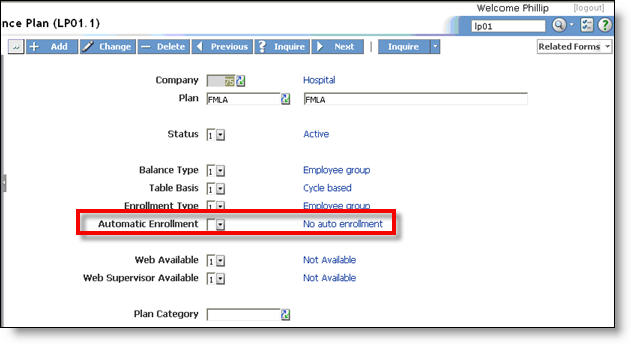
Create Employee Group
While anyone can be eligible for a plan, organizations typically should do a personnel action on PA52.1 to move the employee into a leave status (as well as populate intermittent leave and leave start date user fields). Using a group in this fashion makes identifying employees on leave much easier.
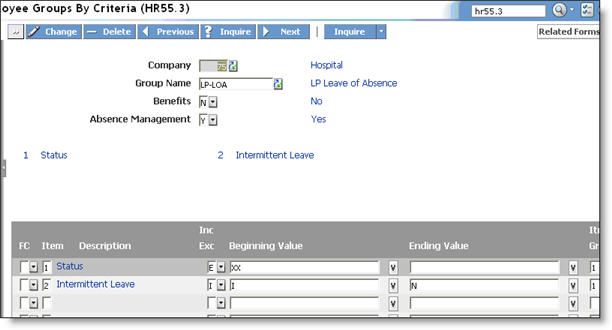
Add Service Rule
The service rule determines when the employee service date is calculated. While other plans such as sick or vacation might use hire or adjusted hire date, the date that an employee goes out on FMLA could occur multiple times during an employee’s tenure. As such, we will use a user field and ensure that that field is tied to the personnel action on PA50.
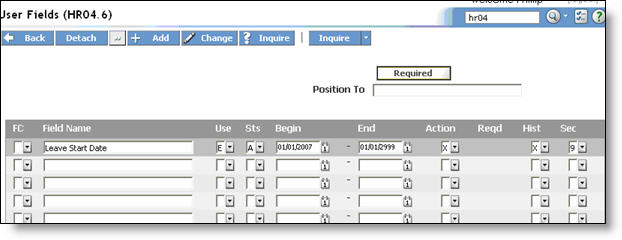
Now that we have added the user field, we can tie it to the service rule.
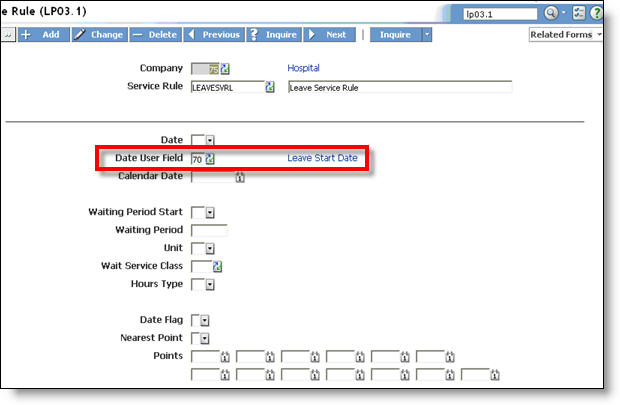
Add Accrual Rule
We need to allot the employees 480 hours of time once s/he enters the plan for full-time employees. Let’s start by adding the calculation for 480 hours of job protection. Note that this calculation is tied to FTE; an employee with 0.5 FTE would receive 240 hours of leave:
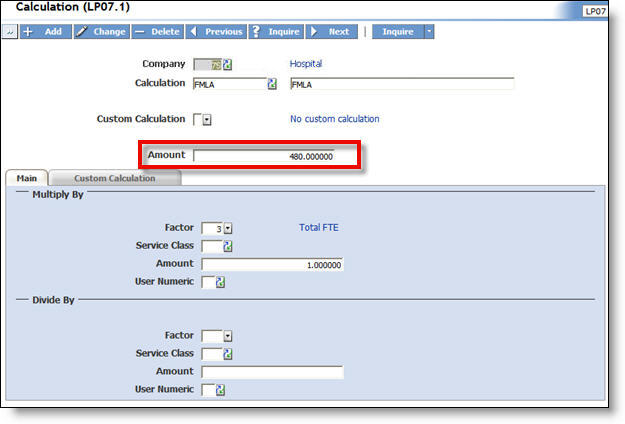
Next, add a cycle based allotment table, and tie the allotment table to the calculation.
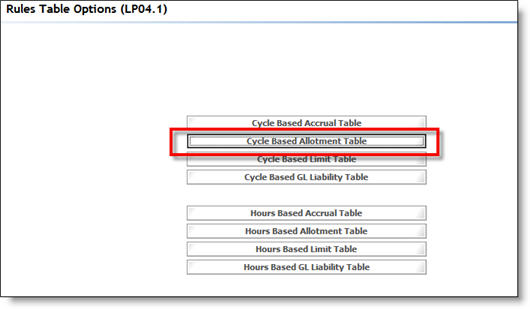
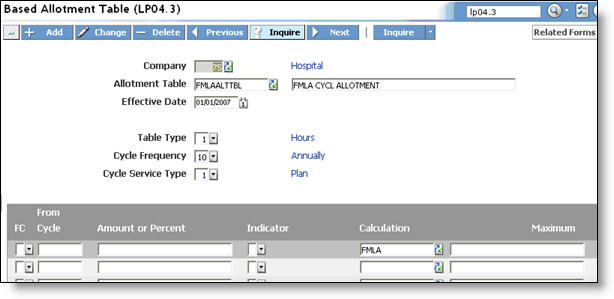
Then add the Accrual Rule, tying it to the Allotment Table:
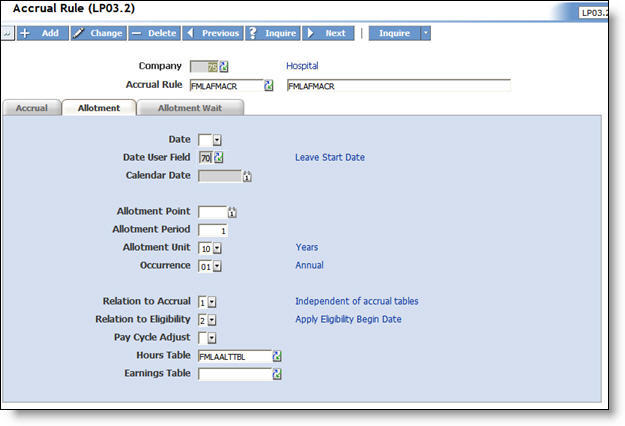
Add Eligibility Rule
Typically, organizations allow employees to take FMLA leave immediately. Note that this is very different than determining employee eligibility via the LP51 and the LP251!
In English, these parameters just mean that employees enrolled in the plan can take their time immediately.
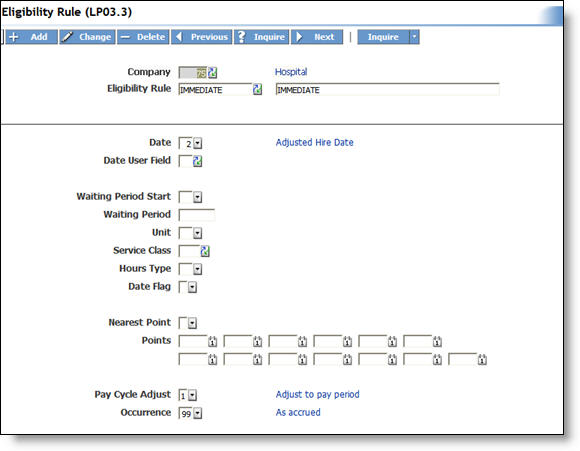
Add Limit Rule
Now, we don’t want employees to take more than 480 hours (12 weeks X 40 hours/week) in a given year. As such, let’s set up the limit table on LP04.4. The problem with using an FTE-based calculation here is that employee FTE values may change during the year and it’s simpler to just use the 480 number.
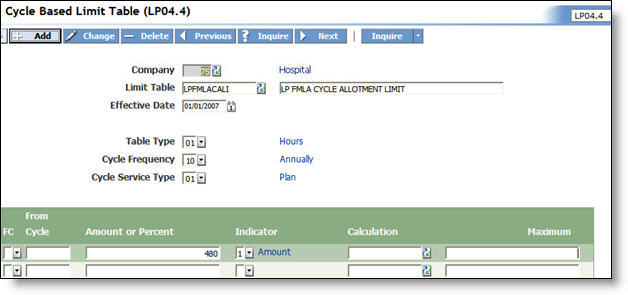
We tie this table to the limit rule. Now, we are ready to add the Limit Rule.
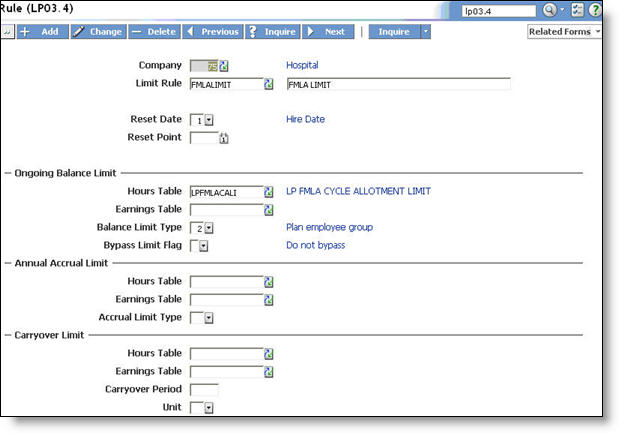
Add Payroll Rule
Note that LP gives clients much more flexibility for printing employee LP balances. Note that you have to use the PMTOUT file via the PR160 for balances to appear on pay checks. This may be a change for some clients who used the PR160.prt output in TA.
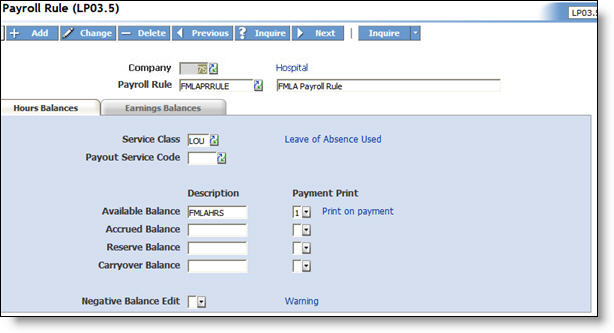
Also note that it’s best not to set the negative balance edit to ‘error’, as the LP140 can be processed for manuals and events only (option #4) to save time. If the employee time records are not in the system, then LP140 won’t pick them up (unless you add them separately via LP53, in my view an unnecessary step). I recommend letting employees go negative here and then creating a simple Crystal, Access, or MS Add-in report for auditing purposes. You don’t want employees taking more than 480 hours of LOA time.
One final note: Make sure to have your service class and code relationships defined for proper tracking of service history:
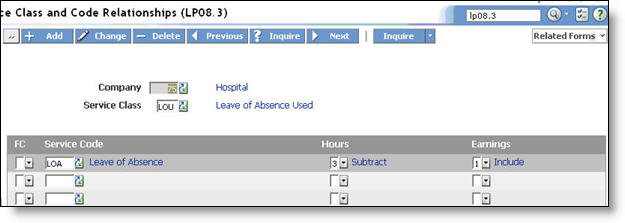
Add Structure
Having added your rules separately, you’re now ready to add your Plan Structure!
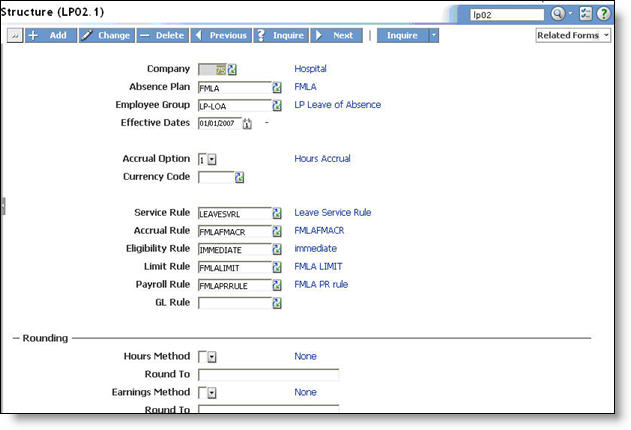
Conclusion/Summary
Compared to Time Accrual (TA), Absence Management (LP) does a superior job of tracking employee leaves of absence, and gives Lawson clients a compelling reason to upgrade to Lawson 9.0 Applications, In addition, Lawson has announced the decommission of the TA module, effective June 1, 2009. By following these steps, you can ensure accurate tracking of employee FMLA balances in Absence Management.
2. PFI, Part 1: The Introduction
Now that you've finished (or hopefully are well on your way toward finishing!) your migration to LSF9, it's time to start using your Lawson solution for all the reasons that you purchased ERP in the first place. This article series will examine the various ProcessFlow components, and delve further into the advanced flow capabilities offered by ProcessFlow Integrator. Since ProcessFlow Integrator is cross-platform, it applies to all Lawson users: UNIX, Windows and iSeries.
What Is It?
ProcessFlow Integrator is Lawson's premier toolset for automating your business processes within Lawson, as well as for integrating Lawson with your external applications. With LSF9, Lawson has merged the best features from Business Component Integrator (BCI) into ProcessFlow to create ProcessFlow Integrator 9.0. With these advanced capabilities, like SQL queries/updates, support for web services, reading/writing files, etc., ProcessFlow Integrator is your opportunity to re-architect your integrator.
ProcessFlow Integrator gives you the capability to implement systemic consistencies, which are central to achieving regulatory and/or voluntary compliance, e.g. Sarbanes-Oxley. Your goal—when you purchased ERP—was to become a process-driven, rather than function-driven, organization. Right?
Once you become process-driven, you can use the metrics collected by ProcessFlow to determine where your bottlenecks exist. And with automatic escalation, you can re-route flows that sit in someone’s Inbasket too long. Or perhaps decide to rework a process to eliminate that person as a bottleneck.
Well, the key, of course, is ProcessFlow. Every significant business action (e.g. adding an employee, releasing an invoice, etc.) which requires coordination across your organization can trigger a corresponding ProcessFlow. Lawson delivers triggers for certain business scenarios; you can augment that by creating your own using Lawson Design Studio.
Do I Own It?
Well, maybe. Lawson offers several different editions of ProcessFlow. In a future article, we’ll look in more detail at some of the features which distinguish them, but here is a summary:
- ProcessFlow Standard, which is included with your Environment / LSF9 purchase. ProcessFlow Standard provides basic workflow capability, with the ability to query against Lawson tables, update Lawson forms, send emails, etc. But ProcessFlow Standard does not include the orchestration and integration features provided by ProcessFlow Professional and Integrator.
- ProcessFlow Professional, an upgraded version of Standard, which adds user actions and work objects (we’ll cover those topics in future articles, but suffice it to say that they are way in which you assign and manage process-driven work within an organization)
- ProcessFlow Integrator, includes all of the capabilities of Standard and Professional, but adds—most significantly—the ability to integrate with other systems, via SQL database connections, web services, files, etc.
- Additionally, Lawson (just to confuse us, I suppose) still sells “Business Component Integrator”, which has been upgraded in LSF9 to use the ProcessFlow Designer, and includes most of the capabilities of ProcessFlow Integrator but not the user actions and work objects included in ProcessFlow Professional and ProcessFlow Integrator.
So, yes, you do own ProcessFlow Standard; perhaps you’ve upgraded to ProcessFlow Professional, and hopefully you own (or will see why you should purchase the premier edition: ProcessFlow Integrator.
3. Worthwhile Reading
Standards For IT Governance
- QUOTE OF THE ISSUE –
“The pure and simple truth is
rarely pure and never simple.”
-- Oscar Wilde
ITIL, COBIT, and ISO 17799 provide a blueprint for managing IT services.
Information Week, December 10, 2007
http://www.informationweek.com/news/showArticle.jhtml?articleID=204701897
Defining Success
There are lessons to be learned when defining IT project success.
Dr. Dobb's Journal, December 2007
http://www.ddj.com/architect/202800777
Pastry parlay: From Au Bon Pain to Panera
How Panera Bread founder Ron Shaich sold his first business to build his second.
Fortune Small Business, December 2007/January 2008
http://money.cnn.com/2007/12/06/smbusiness/panerabread.fsb/index.htm
Analytics Brief: Gaining Value From ILM
An information life-cycle management strategy is key to addressing expanding data volumes and regulations for data archiving and retrieval.
Information Week, December 3, 2007
http://www.informationweek.com/story/showArticle.jhtml?articleID=204301244
4. Lawson Tips & Tricks
WWhen you do a full product line re-compile, and you have customizations, you might find that some of your customizations don't get re-compiled. Typically, this is because they don't have the correct settings in pgmdef, like the 'In Production' setting:
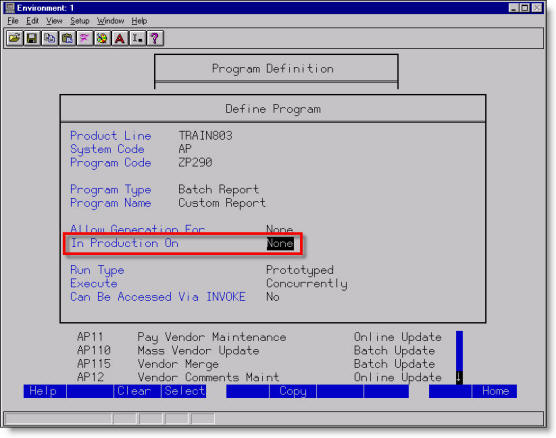
Double-checking the pgmdef settings is always a pain. Here are a couple of rngdbdump commands you can use against GEN.
1) Programs which don't have the 'in production' flag set (and therefore aren't compiled by cobcmp or patchcompile):
$ rngdbdump -c GEN PROGRAM -f ProgramCode -v ProductLine=PROD IsProduction=0
2) Program which have the type set to 'Prototyped and 4GL' (which will have empty .xml files created and generate Portal errors...)
$ rngdbdump -c GEN EXECUTABLE -f ProgramCode -v ProductLine=PROD RunType=2
© Copyright 2008, Decision Analytics. All rights reserved.
Please share The LawsonGuru Letter in whole or in part as long as copyright and attribution are always included.
Lawson® is a registered trademark of Lawson Software, Inc. The LawsonGuru Letter is neither affiliated with nor sponsored by Lawson Software, Inc.
Lawson Software, Inc. is not responsible for the content of this information.
Decision Analytics is an independent consultancy, focusing on Lawson technical projects, and specializing in reporting, customization/modification, data conversion, and integration/interfaces. Please visit https://www.danalytics.com for more information.